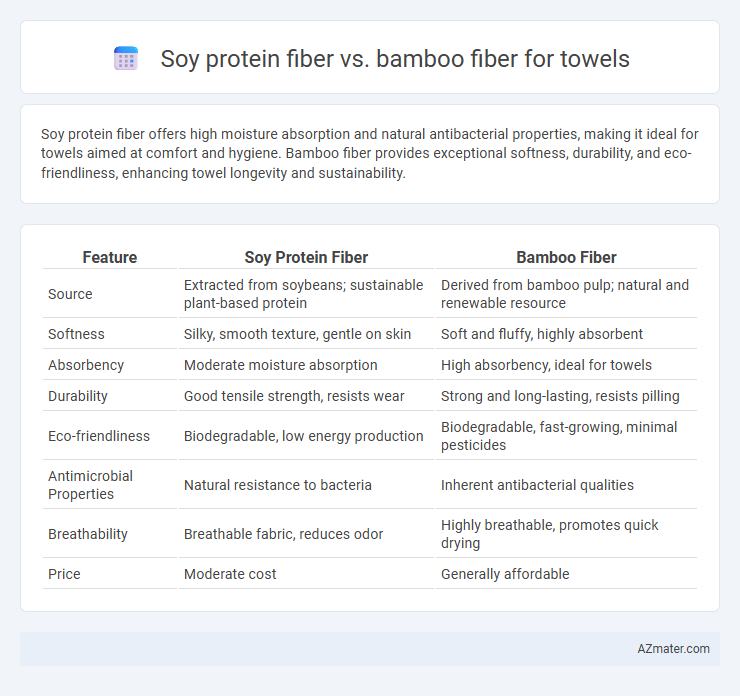Soy protein fiber offers high moisture absorption and natural antibacterial properties, making it ideal for towels aimed at comfort and hygiene. Bamboo fiber provides exceptional softness, durability, and eco-friendliness, enhancing towel longevity and sustainability.
Table of Comparison
| Feature | Soy Protein Fiber | Bamboo Fiber |
|---|---|---|
| Source | Extracted from soybeans; sustainable plant-based protein | Derived from bamboo pulp; natural and renewable resource |
| Softness | Silky, smooth texture, gentle on skin | Soft and fluffy, highly absorbent |
| Absorbency | Moderate moisture absorption | High absorbency, ideal for towels |
| Durability | Good tensile strength, resists wear | Strong and long-lasting, resists pilling |
| Eco-friendliness | Biodegradable, low energy production | Biodegradable, fast-growing, minimal pesticides |
| Antimicrobial Properties | Natural resistance to bacteria | Inherent antibacterial qualities |
| Breathability | Breathable fabric, reduces odor | Highly breathable, promotes quick drying |
| Price | Moderate cost | Generally affordable |
Introduction: Comparing Soy Protein Fiber and Bamboo Fiber
Soy protein fiber offers excellent moisture absorption and a soft, smooth texture, making it ideal for towels that require hypoallergenic and eco-friendly properties. Bamboo fiber is naturally antibacterial, highly absorbent, and known for its durability and quick-drying qualities in towel applications. Comparing their environmental impact, soy protein fiber is derived from renewable soybeans with minimal chemical processing, while bamboo fiber boasts fast growth and biodegradability, contributing to sustainable textile production.
Eco-Friendliness and Sustainability
Soy protein fiber, derived from sustainable soybean byproducts, offers excellent biodegradability and low environmental impact during production, making it a highly eco-friendly choice for towels. Bamboo fiber, known for its rapid growth and minimal need for pesticides, provides strong sustainability benefits and natural antimicrobial properties, enhancing towel hygiene and longevity. Both fibers contribute significantly to reducing reliance on synthetic materials, with soy fiber emphasizing circular economy principles and bamboo fiber excelling in renewable resource use and carbon footprint reduction.
Fiber Origin and Production Process
Soy protein fiber is derived from soybeans, utilizing residual proteins from soybean oil production through a biological regeneration process that transforms the proteins into soft, breathable fibers. Bamboo fiber originates from bamboo plants, created via mechanical crushing and enzymatic treatment or chemical processing to break down the cellulose into fibers suitable for textile applications. The production of soy protein fiber emphasizes sustainability by repurposing agricultural byproducts, while bamboo fiber's process focuses on extracting durable fibers from fast-growing, renewable bamboo stalks, influencing their respective textures and environmental footprints in towel manufacturing.
Softness and Comfort
Soy protein fiber towels offer exceptional softness and a silk-like texture, enhancing comfort with their smooth, gentle feel on the skin. Bamboo fiber towels are highly absorbent and naturally antimicrobial, providing a plush yet breathable experience that maintains comfort even during extended use. Both fibers ensure a luxurious touch, though soy protein towels excel in softness while bamboo towels prioritize moisture management and durability.
Absorbency and Moisture Wicking
Soy protein fiber towels exhibit excellent absorbency due to their natural hydrophilic properties, allowing them to quickly soak up moisture and maintain softness after multiple washes. Bamboo fiber towels are renowned for superior moisture-wicking capabilities, efficiently drawing sweat away from the skin to promote faster drying and enhanced breathability. When comparing absorbency, soy protein fiber generally outperforms bamboo, whereas bamboo excels in moisture management and antimicrobial benefits, making each fiber suitable for different towel performance needs.
Antibacterial and Hypoallergenic Properties
Soy protein fiber exhibits strong antibacterial properties due to its natural isoflavones, which inhibit bacterial growth and reduce odors, making it ideal for towels used in sensitive skin environments. Bamboo fiber contains natural antimicrobial agents like bamboo kun, providing effective resistance against bacteria and fungi while maintaining hypoallergenic qualities suitable for individuals prone to allergies. Towels made from these fibers combine eco-friendly benefits with superior hygiene, offering a softer, safer alternative to traditional cotton fabrics.
Durability and Longevity
Soy protein fiber towels exhibit impressive durability due to their strong peptide chains, which resist wear and maintain shape after multiple washes. Bamboo fiber towels offer excellent longevity attributed to their natural antibacterial properties and inherent moisture-wicking abilities, reducing fiber degradation over time. When prioritizing durability and lifespan, soy protein fiber provides enhanced tensile strength, while bamboo fiber excels in maintaining freshness and softness during prolonged use.
Care and Maintenance Requirements
Soy protein fiber towels require gentle washing with mild detergents to preserve their softness and durability, avoiding high temperatures that can degrade protein-based fibers. Bamboo fiber towels benefit from cold to warm water washes and should be air-dried or tumble-dried on low heat to maintain their natural antibacterial properties and prevent shrinkage. Both fibers demand minimal ironing, but soy protein fiber is more sensitive to strong chemicals and excessive heat compared to bamboo fiber.
Cost and Market Availability
Soy protein fiber towels generally offer a lower production cost due to the abundance of soybeans and established processing techniques, making them more affordable in large-scale manufacturing. Bamboo fiber towels tend to have higher costs driven by more complex extraction processes and growing consumer demand for eco-friendly textiles. Market availability favors soy protein fiber towels in mainstream retail, while bamboo fiber towels are commonly found in niche markets emphasizing sustainability and premium quality.
Final Verdict: Choosing the Right Fiber for Towels
Soy protein fiber offers exceptional softness and moisture-wicking properties, making towels highly absorbent and gentle on the skin. Bamboo fiber stands out for its antibacterial qualities and durability, ensuring towels remain fresh and long-lasting with minimal odor retention. Choosing the right fiber depends on prioritizing softness and eco-friendliness with soy protein fiber or favoring enhanced hygiene and strength with bamboo fiber for towel use.

Infographic: Soy protein fiber vs Bamboo fiber for Towel
 azmater.com
azmater.com